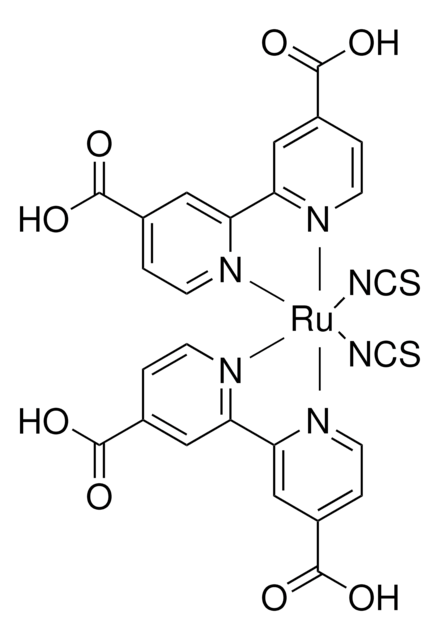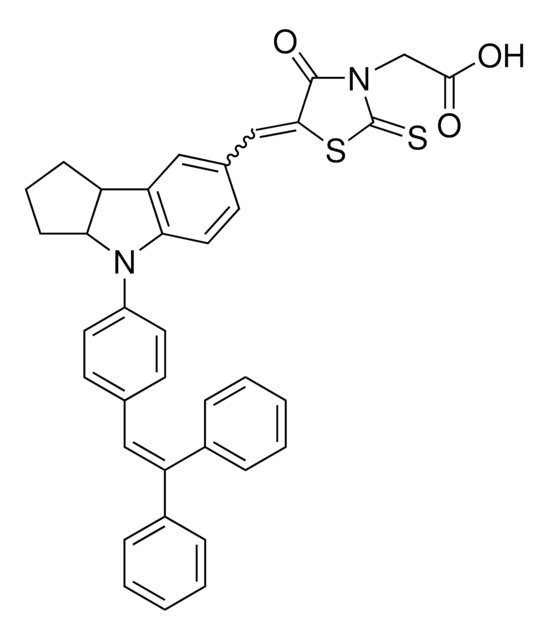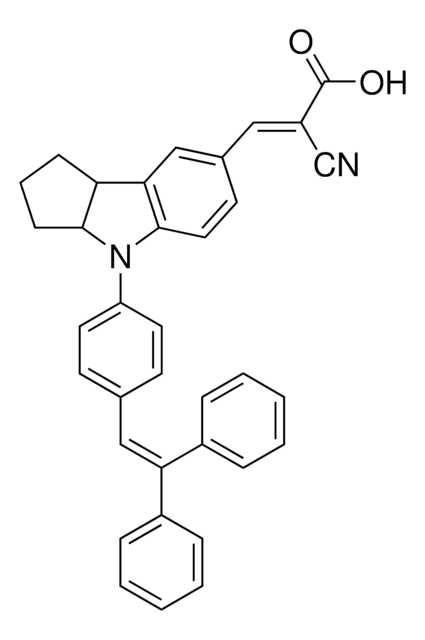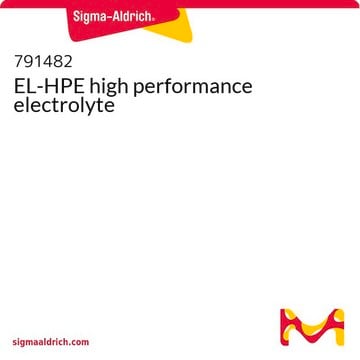791245
N749 Black Dye
Synonym(s):
Greatcell Solar®, Black dye, Ruthenium 620, Tris(N,N,N-tributyl-1-butanaminium)[[2,2′′6′,2′′-terpyridine]-4,4′,4′′-tricarboxylato(3-)-N1,N1′,N1′′]tris(thiocyanato-N)hydrogen ruthenate(4-)
About This Item
Recommended Products
Assay
85% (HPLC)
form
powder
color
dark green
λmax
615, 415, 341, 329 nm at 0.02 mM in ethanol (lit.)
SMILES string
CCCC[N+](CCCC)(CCCC)CCCC.[O-]C(C1=CC(C2=NC=CC(C([O-])=O)=C2)=NC(C3=CC(C([O-])=O)=CC=N3)=C1)=O.S=C=N[Ru](N=C=S)N=C=S.CCCC[N+](CCCC)(CCCC)CCCC.CCCC[N+](CCCC)(CCCC)CCCC
InChI
1S/C18H11N3O6.3C16H36N.3CNS.Ru/c22-16(23)9-1-3-19-12(5-9)14-7-11(18(26)27)8-15(21-14)13-6-10(17(24)25)2-4-20-13;3*1-5-9-13-17(14-10-6-2,15-11-7-3)16-12-8-4;3*2-1-3;/h1-8H,(H,22,23)(H,24,25)(H,26,27);3*5-16H2,1-4H3;;;;/q;3*+1;3*-1;+3/p-3
InChI key
YOIDEEDNCKVVPH-UHFFFAOYSA-K
General description
Application
Recommended application in 0.2-0.3mM solution with ethanol or acetonitrile/tert-butanol (1:1; vol:vol).
Legal Information
Signal Word
Warning
Hazard Statements
Precautionary Statements
Hazard Classifications
Eye Irrit. 2 - Skin Irrit. 2 - Skin Sens. 1 - STOT SE 3
Target Organs
Respiratory system
Storage Class Code
11 - Combustible Solids
WGK
WGK 3
Flash Point(F)
Not applicable
Flash Point(C)
Not applicable
Certificates of Analysis (COA)
Search for Certificates of Analysis (COA) by entering the products Lot/Batch Number. Lot and Batch Numbers can be found on a product’s label following the words ‘Lot’ or ‘Batch’.
Already Own This Product?
Find documentation for the products that you have recently purchased in the Document Library.
Customers Also Viewed
Articles
Dye-sensitized solar cells (DSCs) are 3rd generation solar cells combining the promise of high efficiency with low production costs.
While dye sensitization as the basis for color photography has been accepted for a very long time,1 attempts to use this principle for the conversion of solar light to electricity generally had resulted only in very low photocurrents, below 100 nA/cm
Our team of scientists has experience in all areas of research including Life Science, Material Science, Chemical Synthesis, Chromatography, Analytical and many others.
Contact Technical Service












